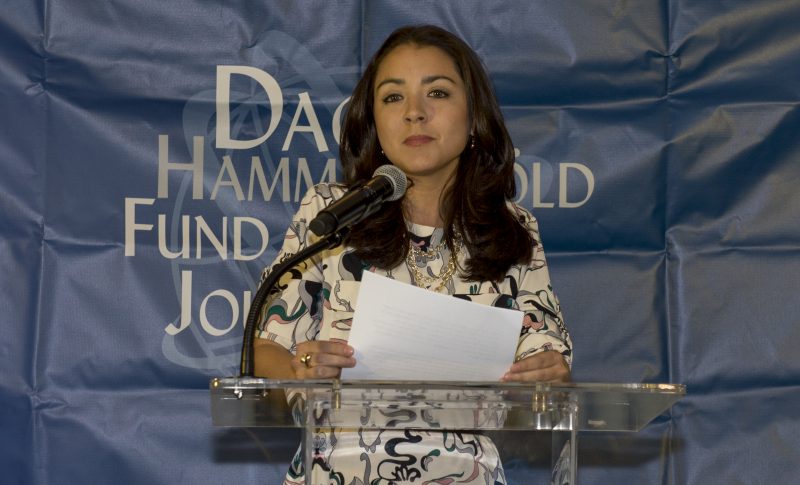
Maria Julia Arana speaking at the United Nations in New York. Photo by the UN.
Massive labour migration from Central Asia to Russia is a comparatively new trend in that it started around 25 years ago when the five Central Asian countries gained independence and only really exploded when the Russian economy began to surge on the back of rising energy prices after the milennium.
Currently, seasonal migration is undergoing a transformation into immigration, as many of the region's mostly male migrants have cut ties with home countries and even their families, while a greater number of women from these traditional societies have now begun lives as migrants themselves.
Latin American countries have already undergone this transformation. While talking to Maria Julia Arana, a Bolivian-Argentinian journalist specialising in migration, this Global Voices author found that Bolivia's own migration story has much to help us inform our understanding of processes that are ongoing in Central Asia and understand their future impact.

Dag Hammarskjöld Scholarship fellow Maria Julia Arana. Photo by the United Nations.
Global Voices: What is the current situation in terms of Bolivian out-migration?
Maria Julia Arana: Argentina was once the only and still remains the main destination for labor migrants from Bolivia. When Argentina was hit by a financial crisis at the beginning of the milennium, Brazil, Spain and the United States became alternative routes for Bolivian migrants.
More than three million Bolivians out of a population of 11 million go abroad to seek work, and according to official statistics, 73% of all Bolivian migrants now go to Argentina.
The first migrants moved to Argentina looking for better work opportunities firstly in the borderland areas (mining and agricultural jobs). These moves were mostly seasonal and temporary, and mostly it was men who were leaving for these jobs. Soon, Bolivians started moving to big cities, like Buenos Aires, and women also had to move seeking work. Now, around 30% of labor migrants from Bolivia in Argentina are women, who work at homes, in manufacturing and in the service industries.
The feminization of migration was propitiated not only by the labor market’s demand for domestic workers and caretakers in Argentina and Spain, but also due to a transformation of Bolivian society into one where women had become accustomed to being the main breadwinners in their families.
GV: Do migrants take their families to their countries of destination? If not, how frequently do they send money back home and visit families?
MJA: Bolivian immigrants don’t travel with their families. In the best scenario if the immigrant has established permanent residency in the host country and achieved some economic stability, then they can bring their children to live with them.
The country does not rely fully on remittances from migrants, however, as they represent just 3% of the GDP now. [Editor's note: In Tajikistan remittances equated to around 40% of GDP in 2015 while in Kyrgyzstan they were around a third].
There is not much information on how frequently migrants send money back home. Many of them live illegally, and they use informal transfer services, making it difficult to track the flow.
Visiting families are also restricted by the legal status of a migrant, especially in Spain, where immigration laws are tough. Restrictions on circular mobility [going out and coming in again] has a resounding impact on family structures, rearranging relationships, both between genders and between generations.
Argentina’s more permissive migration laws allow for more frequent returns to Bolivia. This legal context provides increased flexibility for Bolivian migrants to enter, return and live as citizens in their host country.

A Bolivian woman in the highlands of the country. Shared on Flickr by the European Commission DG ECHO Flickr account.
GV: What impact does the long absence of parents have on children, elderlies and spouses? Does it change social traditions and cultural values too? In what way? Can you highlight some examples?
MJA: Any family separation is a difficult situation for its members. Migration triggers a variety of reactions in both the person, who emigrates and in his or her family members. Some studies like the one by Captura Consulting have found that in periods of increased external migration the divorce rate increases also. The effects of migration fall mainly on the children. They are the most affected by the departure of their parents. The absence of moral, emotional and physical reference has effects on child rearing.
However, these impacts are processed differently by each person. In families that have grandparents or uncles to rely on, the children have more opportunities to grow with family values and receive a well-rounded education. In the case of the poorest families, where only the father is in charge of economic support, it is common that they have two or more jobs which reduce the time spent with children. In these situations most vulnerable children are prone to fall into drugs, gangs and all kinds of other problems.
Migration also generates changes in intergenerational and gender relationships. This issue was largely studied by the anthropologist Sònia Parella, who notes that in the last thirty years there have been major changes in gender roles in the families, especially when the mother is the one who emigrates. Pioneering female migration generates cracks around the traditional role of “wife” and “mother” and for the role of men as financial providers.
This type of migration affects family values and the traditional roles of men and women, and it is one of the main impacts of migration on Bolivian society. This can also be seen as an opportunity for women's empowerment. Sociologist Lara Merella speaks of “transnational families” to describe these new family ties that result from migration processes.
GV: So, you have generations of people that have grown up with one parent, or who are practically self-raised. Now these “children of migrants” are adults, what differences can you observe between them and their parents?
MJA: I think this generation has grown up without parental figures and without understanding the ‘value of work’ because they have not seen their fathers or mothers go out to work every morning. Another characteristic of these young people is that they are more likely to move, travel and settle in different cities or countries without difficulty or without the same difficulties as their parents encountered.
This nomadic lifestyle also interferes with education and increases the risks of crime. This said, I cannot say for sure that there is data that directly links crime to parental migration. Moreover, the presence of parents does not always guarantee the good upbringing of children.
The important issue is not migration itself, but conditions of migration. If families have sufficient support from relatives, uncles, and grandparents to delegate education of children, then a good upbringing can be guaranteed.

Tajik migrants pray for Eid al-Fitr in Moscow on August 8, 2013. David Trilling for Eurasianet.org. Creative commons.
GV: Do you think all these impacts of labor migration that we have discussed apply only to Bolivia due to its specific environment and culture, or might we see similar results in other parts of the world that have high out-migration?
MJA: There are many studies that have indeed detected the same effects in other Latin American families due to migration. There are thus many similarities with other Latin American countries. I cannot say that you can transfer the same circumstances of migration to other parts of the world. But, I do think that the reconfigurations of families due to migration are generating changes in terms of roles across generations, genders and parenting in many parts of the world.
I think the feminization of migration is the most interesting issue to study and is the most related to Bolivian culture. I do not think we can translate this phenomenon to countries where gender roles are determined by religion and by more conservative cultures. Also, I have read that some countries like Afghanistan, Pakistan, Sudan and Uganda, among others, have policies to discourage or forbid women from emigrating.
GV: Are there any positive aspects to labor migration?
MJA: Yes. Remittances have definitely had a direct influence on Bolivia’s economic growth. They are sent expressly to improve the quality of life of family members who stay behind.
Empirical studies suggest that both immigration and emigration have impacts on foreign trade also, confirming the positive and significant effect of immigration on exports and imports in Bolivia. Another positive impact is the new social bonds created between immigrants and locals.
Migration from Bolivia has had an impact on the growth of the agricultural sector in Argentina and has led to a decrease in food prices there, too. Another important impact of migration is education. The free and superior educational system in Argentina allows Bolivian children to get a better education and help them grow themselves in their new country.







1 comment